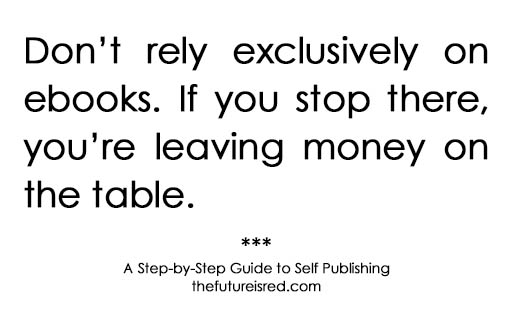Welcome to part two of the incredibly informative interview with Chris Rachael Oseland. You may remember her from her post last month all about how-to build your writer’s platform. Start way in advance of publishing your book.
Those are the people who will support your Kickstarters (Chris’ was just successfully funded, by the way, and I am not anxiously awaiting my own Dining With the Doctor cookbook). They are the ones who will buy your book.
So. Then. How do you go from that initial idea stage of a book to its final appearance on Amazon?
I give you: Chris Rachael Oseland.
***
Phew. Grab a drink, folks. This will take a couple paragraphs.
I’m still early enough in my career that I haven’t depleted fandoms I love. We live in a golden age of geek culture, so I’m actually inundated with more awesomeness than I can keep up with. Last year, while I was working on An Unexpected Cookbook, I desperately wanted to follow it up with a Sleepy Hollow cookbook, but I just couldn’t fit it into my writing schedule. (I have a MA in history, so really, an excuse to geek out about fantasy AND history in a way people will actually read? I still drool at the thought!)
I can’t stress this enough. If you want to succeed in self publishing, you absolutely MUST adore your subject matter on a bone deep, borderline creepy level. You will be living with it day and night for the next couple of years, and you need to keep the enthusiasm up for your audience as well as yourself.
Will your new idea find an audience?
I keep an idea log. When I come up with a new book idea, I run it past a few trusted friends to see if they think it’s a fraction as brilliant as I do. If they agree it belongs in the queue, I’ll give it a dry run on Kitchen Overlord to see if total strangers agree that it’s pretty nifty.
An Unexpected Cookbook started as a week of Hobbit recipe posts on Kitchen Overlord. The feedback was amazing. People loved the historical facts about Tolkien’s life and the real world food that inspired the Shire. Wait…they want me to write about history AND food? THIS MUST HAPPEN.
When I get affirmation that yes, people really DO want more of an idea, I let myself fall down a research rabbit hole. With The Hobbit, that meant re-reading the books. Kindle is GREAT for this because you can easily search for specific words and terms. Also, that meant getting a lot of source material via inter-library loan, and indulging in a crazy amount of research about the specific time and place that inspired the Shire.
As a contrast, for Dining With the Doctor, that means re-watching every episode several times with a notebook in hand. First, are there any references to food? If so, replicate that recipe. Second, is this episode set in a specific point in history? If so, find a relevant recipe from that era which won’t gross out modern tastes. Third, is there an iconic alien? People really want recipes for Daleks, Cybermen, Ood, and other aliens people will instantly recognize. Once I have the recipe, then I go back and rewatch the episode again for recap purposes. This is why I say you have to ADORE your material. With 116 episodes of Doctor Who, that’s a 348+ hour commitment before I even start cooking or writing.
Testing, testing and sometimes failing
Once I finish the research stage, it’s time to start creating and testing recipes. Some things fail.
 I love my first attempt at Pika-Chews so much. Instead of adorable Pokemon, the rolls looked like DEMON BUNNIES HERE TO EAT YOUR SOUL. The photos in my books are all of food I actually cooked and plated myself.
I love my first attempt at Pika-Chews so much. Instead of adorable Pokemon, the rolls looked like DEMON BUNNIES HERE TO EAT YOUR SOUL. The photos in my books are all of food I actually cooked and plated myself.
Next, I typically make all the food in a chapter for a marathon photo session. Once all the recipes are photographed, I can finally write them up. Then I move on to the next chapter. My recipes include a lot of recaps, historical details, and snark. Most are between 500-800 words, though I’ve been known to top 2000 on Kitchen Overlord, so they don’t read like the usual cookbook list of ingredients followed by a numbered list of steps.
Food writers tell me this is appalling and will doom me to failure, but if you look at the Amazon reviews for An Unexpected Cookbook, those meandering details and reassurances that you can do this are what people love best.
The tedious details of lay out, formatting the actual book
Once everything is photographed and written up, I lay out the book. Eventually, I aspire to make enough to outsource this part, but for now, it’s still in my hands. At this stage, I also commission a cover and buy my ISBN from Bowker.
Now that I have a PDF of the final manuscript, I can send it to my printer or CreateSpace. I also send the completed document to a professional Kindle formatter. I can do it myself, but for books with so many pictures, freeing up my time is totally worth $150-200.
Printers typically tell you they’ll ship a book in 5-8 weeks, but I have yet to find one that delivers in less than 12. If you’re launching a book around the holiday season, it’s best to add on another 4-5 weeks. While I’m waiting on the printing, I create the Amazon landing page and start my pre-marketing campaign to build up buzz.
There are so many small steps necessary to get the books from the printers to Amazon’s warehouse that I could write a whole separate article on the process. For an article this length it’s best to say; Collect Underpants, Step 2, Profit.
Once the books are in Amazon’s warehouse and linked to your landing page, you can finally start selling them!
How long will this take?
Adding it all together, it typically takes me 14-18 months from, “Ooh, can I really pull this off?” to “Guess what? It’s for sale on Amazon!”
To maintain my publishing schedule I’m perpetually working on two books at a time. The Illustrated Geek Cookbook overlapped with An Unexpected Cookbook, for example, and I’m currently working on both a Horror cookbook and Dining With the Doctor: Regenerated.
 I quite like working on two books at a time. It keeps me from burning out. If I can’t stare at another edible rendition of a body part today, I can work on a TARDIS instead.
I quite like working on two books at a time. It keeps me from burning out. If I can’t stare at another edible rendition of a body part today, I can work on a TARDIS instead.
What are the two most important things anyone who wants to self publish should know?
Don’t rely exclusively on ebooks. Kindle is great. Heck, I got my start there. But if you stop there, you’re leaving money on the table. For books without photos, I can’t say enough good things about Amazon’s print-on-demand property, CreateSpace. You upload a PDF, which is worlds easier than formatting an ebook, and your cover, write the product description. Amazon takes care of the rest. They create your product page, your book is eligible for Prime shipping, and you can order copies at a discount if you want to get it into libraries or bookstores.
Just like the big publishers, I make 80% of my yearly sales in a 6 week period from Thanksgiving through the week after New Year’s. People want to give physical books their loved ones can unwrap. Ebooks are great, but I make a heck of a lot more off the print editions.
The cover is everything!
Whether you’re writing an ebook or print book, pay for a quality cover. Mine usually cost around $500, and if you look at An Unexpected Cookbook: The Unofficial Book of Hobbit Cookery and Dining With the Doctor: The Unofficial Whovian Cookbook, it shows. If you don’t need to include specific photos or iconography, you can get some really fantastic covers much cheaper than that. I recommend Humble Nations. In fact, I know some folks who will surf his covers for inspiration when they have writer’s block.
***
And there you have it. A concise overview of how-to write and self publish your book. Thank you so much to Chris for taking the time to answer all my questions in such detail.

